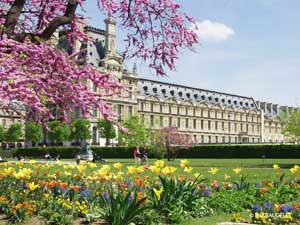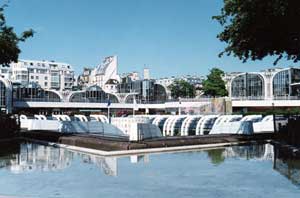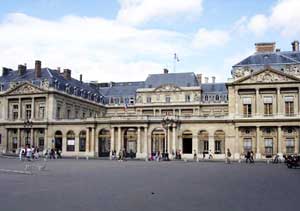Paris's Châtelet-Les Halles describes an area the doesn't encompass much ground but is a study in contrasts from the heights of Faubourg St-Honoré to the lowly beginnings of Les Halles. To cap it all off, in the middle of this apparent oxymoron stands the Louvre.
Châtelet-Les Halles is perhaps the area with the biggest tourist concentration (which is saying something in the city of never-ending sights) but this means that it is also the least populated.
The 1st and 2nd arrondissements that make up Châtelet-Les Halles are the smallest, amounting to just over 2.8km2 put together.
That means a lot of tourism in a small space.

Once the haunt of French royalty, the two main tourists attractions in the area have been turned over to the plebeians: the Louvre was the home of French kings for four centuries and the Jardin des Tuileries that surround it were designed for Louis XIV, the Sun King.
The dichotomy of the neighborhood comes from the contrast between the impossibly posh Faubourg St-Honoré contrasted with Les Halles, formerly the city's vermin-infested wholesale food market.
For over three centuries Faubourg St-Honoré has been the number-one destination in the city for fashion lovers with cash to spend. It used to be the royal mistresses that shopped here and now its the world's celebrities and footballer's wives.
Every chic designer label you can think of has a boutique here and it is also home to some of the best hotels in Paris. The French president and the American and British ambassadors have replaced the royalty that used to live here but the area is no less regal.
At the other end of the spectrum, Les Halles was the district that fed Paris for over 800 years, not dressed it.
Émile Zola vividly describes the area in his novel The Belly of Paris, painting a picture of prostitutes weaving in and out of richly stocked stalls and food halls overflowing with meats, fish and vegetables. The problem of the plague of cat-sized rats wasn't solved until the market moved to the suburbs in 1969.

Today, the area is best known for an underground mall named Forum Les Halles which some people say, it isn't really worth the effort. The streets surrounding Les Halles have profited from the renovation of the area and have become some of the trendiest in the city. Hip boutiques, bars and restaurants have sent rent skyrocketing.
One of Paris's main tourist hubs, Châtelet-Les Halles is home to lots of travelers, locals, and unfortunately, scam artists. Needless to say pickpockets are all over this area of the city so move cautiously yet confidently.
Les Halles might have come a long way since its seedy beginning but still not far enough so we advise to avoid this area at night.
While the dominating attraction in Châtelet-Les Halles might be the Louvre (and rightly so) there is so much more to see that it is worth spending a bit of time in this part of Paris. The neighborhood is home to a rich history encompassing royalty and giant rats, haute-couture and fresh -and not so fresh- fruit and veggies.
Most tourists that come to this area head straight for the Louvre, so the other attractions such as the Palais-Royal or the Eglise St-Eustache are ideal if you are interested in learning about the history of paris without fighting through the crowds.
Jardin des Tuileries
The Tuileries has always been a place to see and be seen in Paris, ever since the 17th century. It is about as French as a French formal garden can get with manicured rows of trees and hedges, punctuating verdant lawns and gravels paths. These days it is as popular with locals as it is with tourists and is always bustling with life, regardless of the weather. With the Louvre at one end, the Eiffel Tower to one side and the Musée d'Orsay across a footbridge, the Tuileries makes a perfect pit stop on a sight-seeing tour. If you want to know more, check out the Jardin des Tuileries in the park section of our guide.
The Louvre
This king of all museums doesn't really need much introduction. If you are going to see just one museum during your trip to Paris, in all likelihood it will be the Louvre. It has earned the title of the world's largest art museum with representative examples from almost every civilization on Earth so as well as the 'big three' (Mona Lisa, Venus de Milo and Winged Victory) there is more than enough to keep you busy. For more information about practicalities and the history of the Louvre check out the attraction page.
Comédie Française
In the Place Colette, the stately theater, the Comédie Française, is still going strong after 400 years which is no mean feat. Productions of all the classic French playwrights such as Molière, Racine, and Corneille appear regularly on the bill here but only in French so beware if you don't speak the language.

Palais-Royal
Just a block north of the Louvre, the Palais-Royal is an attraction often neglected by tourists. The building boasts a rich history as it was originally constructed to be Cardinal Richelieu's residence between 1628 and 1642 but he died the year it was finished so the palace passed into royal hands. Today, the stately buildings are home to the Conseil d'Etat and ministry of culture while the rather elegant and unexpected black and white things in the courtyard are a modern installation by Daniel Buren. If you are looking to avoid hordes of tourists while still experiencing some of Paris's history and architecture, the Palais-Royal is the place to go.
Eglise St-Eustache
A lot of distinguished Parisians have been baptized and/or received communion in this majestic church: Cardinal Richelieu, Louis XIV and Mme. de Pompadour all had the pleasure of basking in the beauty of Eglise St-Eustache. The church is enormous and mixes a Gothic structure with Renaissance decoration in its façade and Corinthian capitals. The chapels contain paintings by Rubens and two chapels to the left you will find Keith Haring's The Life of Christ, a triptych in bronze and white-gold patina.